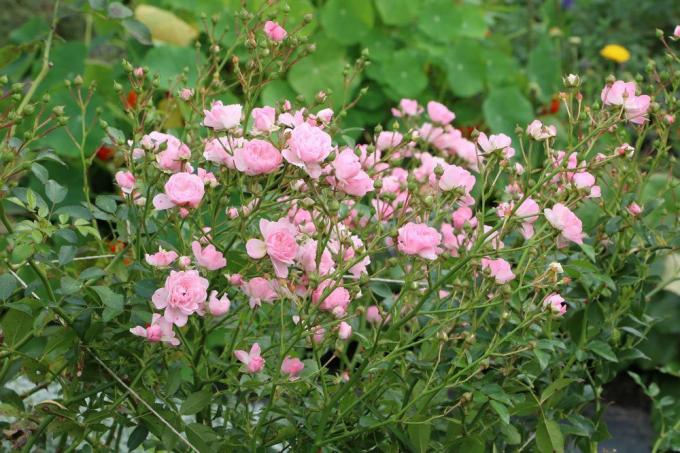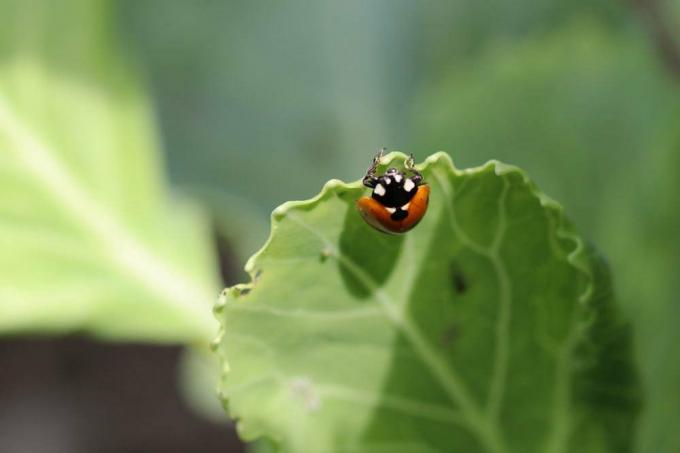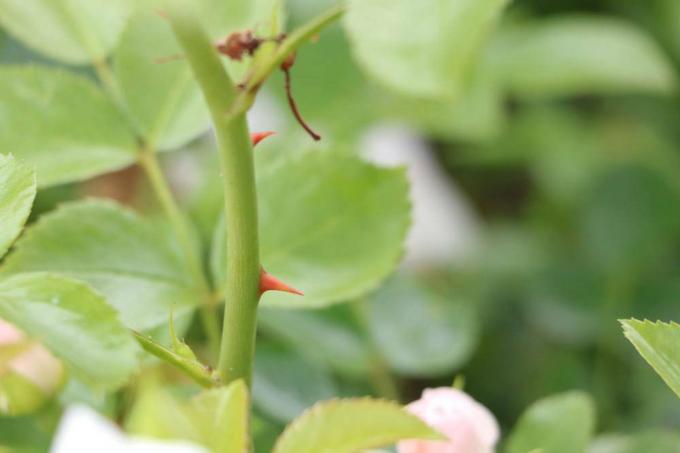
table of contents
- mildew
- Powdery mildew
- Wrong mildew
- Home remedies
- Ablutions
- Milk or whey
- Propellants
- Herbal broths
- Beneficial insects
- Resistant varieties
Roses are eternal favorites in the garden and in your own four walls. Their characteristic flower shape, the scent, even the thorns are a real pleasure for every observer who takes a look at the plants. It is therefore not surprising that rose lovers are frightened when suddenly a floury coating attacks the leaves and the rose weakens. This is the dreaded powdery mildew that is not to be trifled with.
mildew
Powdery mildew on the leaves
When the first rose buds and leaves finally reach the light from the sun's rays in spring, fear of the notorious fungus lawn of powdery mildew also increases. This deposits itself like a weakening layer on every type of rose, whether outdoors or in an apartment, and causes the wonderful plant to perish more and more. So that you do not lose the battle against the fungi, you should eliminate them with home remedies. It is important to know how the two types of powdery mildew can be effectively prevented and controlled.
- Powdery mildew
- Wrong mildew
Powdery mildew
What is powdery mildew?
Powdery mildew is a disease of roses and various types of stone fruit, especially peaches, which is caused by fungi called "Podosphaera pannosa". These molds have specialized in the numerous types of roses and for this reason are also called the real rose dew fungus. This pathogen is one of the best-known types of mildew around the world and has been known for centuries, which is what makes treatment with a suitable home remedy so successful. As soon as the roses are infected with the mycelium, it spreads like a carpet on the plants and the following symptoms occur.

- white, floury coating on the upper side of the leaf
- If the infestation is severe, it spreads to the underside of the leaves, shoot tips, buds and flowers
- Leaves roll up
- Flowers remain closed or do not develop due to dried out buds
- If the surface is extremely large, it can turn brown
- Growth is curbed
- Rose dies
The fungus hinders the metabolism of the roses by attaching itself to the top of the leaves and penetrating the cells of the plant through special suction organs. The fungus can then multiply there without any problems as long as you do not fight it. "Podosphaera pannosa" is a fair weather mushroom. As the name suggests, the spore flight is more effective here as soon as it is warm and dry. Although the infestation can start in spring, the powdery mildew needs temperatures of at least 20 ° C and an alternating high level of humidity in order to be particularly dangerous. He also winters in the following way.
- forms fruiting bodies in late autumn
- these black globules contain spores
- settle on the shoot tips and buds of the rose, also in the garden leaves that have not been disposed of
- in spring, the spores are redistributed when the plant sprouts
This is the reason why this fungus is so stubborn and, if cared for incorrectly, can affect different types of roses, especially if they are weakened or the location is not ideal. Because here applies: the weaker the rose, the easier it is for powdery mildew to play.
Wrong mildew
Downy mildew is also a fungus, but it is caused by the pathogen "Peronospora sparsa". The mold was first discovered in the second half of the 19th century. Century described and specializes in roses and also blackberries. In contrast to the fair weather mushroom, it is a bad weather mushroom and therefore more effective in cooler weather conditions and shows up in spring at around 11 ° C. In addition, it prefers more humid locations, as it makes use of the rain in spring to attack the roses. Downy mildew infestation can be broken down as follows.
- floury fungal lawn in white-gray color on the underside of the leaf
- yellow-brown to purple spots on the upper side of the leaf
- Leaves are thrown off
- affected shoots die off
- Plant becomes weaker and dies

Downy mildew is much more effective than real powdery mildew, as the spores are located directly in the cells of the plant and from there disrupt the entire nutrient balance. In doing so, they drive out their organs and break through the underside of the leaf, which creates the floury coating. You must absolutely prevent the infection by "Peronospora sparsa", as this is more stubborn than the real thing and leads to the death of the rose plants much faster. This applies to indoor and outdoor roses, although roses in the garden are more often affected by this fungus because they use raindrops to spread.
Prevent powdery mildew
If your roses are already infected by the weather fungi, it is often quite difficult to heal them again. For this reason, you should do your best to prevent possible infestation. The most important thing here is the right care for the rose species, as this is the only way they are resistant to fungi. Since rose plants are generally more demanding, you should pay attention to the following points in order to protect the plants from infestation.
- choose a location that has adequate air circulation, as the spores can multiply well in stuffy air conditions
- it should also be very sunny, as this is the only way to dry any rain or condensation on the leaves, which otherwise is a perfect breeding ground for the spores
- The following properties, on the other hand, are beneficial for the mushrooms: dark, damp, corners with poor air circulation
- It is essential that you loosen heavy soils, as they often store too much moisture and are difficult to dry out
- this promotes the formation of the spores and you should absolutely prevent that - enrich it with potassium
- do not forget to water sufficiently and ensure high humidity, as prolonged drought can weaken the roses
- a layer of mulch helps here, especially with garden roses, as long as the soil is permeable and humus
- do not use too many nitrogen-based fertilizers
- do not plant rose plants in a location previously occupied by an infested plant for four years
- the pathogens could still be in the soil and cause an infestation the next time it rains
- do not neglect the correct pruning of the plant and thin out lush crowns well to avoid a possible build-up of heat and air
- Affected parts of the plant should be removed and disposed of immediately, but not on the compost
- Plant parts infected by fungi can either be disposed of with household waste or burned - this will prevent spores from flying
- never water in the evening as the water cannot evaporate until night
- If you water in the morning, the roses can soak up the water better and thus you do not offer a target for the pathogens to attack
- never water the leaves or shoots, only the location itself and the roots, which like to be showered extensively
- Plant herbs among the rose plants
- Because of their active ingredients, basil, chives and chervil act as protective agents against fungi

Keep the following planting distances to avoid build-up heat:
- Miniature roses: 30 - 40 cm
- Flower roses: 30 - 50 cm
- Shrub roses: the distance between the plants corresponds to the height of the plant
- Climbing roses: 2 - 4 cm
- Ground cover roses: 40 - 150 cm (depending on variety)
- Dog roses: 80-100 cm
Home remedies
Home remedies for powdery mildew
There are numerous home remedies that are suitable for combating powdery mildew of both types of fungus. The means are especially recommended so that you don't have to resort to the chemical club. Fungicides can be effective, but are not responsible if you use container plants that are subsequently restored come into the apartment or have a garden that is in close proximity to neighbors or sensitive natural areas. Over the last few centuries, a number of means have been established that you can use to combat powdery mildew on your roses without any problems.
- Ablutions
- Skimmed or raw milk, whey
- Propellants such as baking powder or baking soda
- Herbal broths
- Beneficial insects
Ablutions
Regular washing of the rose family is important in the event of powdery mildew, especially if it is still in the early stages. Use a damp microfiber cloth to wipe the base off and then continue with one of the other home remedies. In this way you can reduce the infestation somewhat and the following agents are then better absorbed into the plant.

Milk or whey
Skimmed and raw milk can be used quite well against an initial infestation. The contained lecithin acts aggressively on the spores and fights them effectively, which helps to eliminate them permanently.
The solution:
- mix 1 liter of raw or skimmed milk with 9 liters of water
- fill the agent in a spray bottle
- treat the plants extensively with the product every two to three days
If you use whey, it does not need to be mixed and can be applied to the plant immediately. A great advantage of milk treatments are the microorganisms they contain, which not only work against fungi, but also strengthen the resistance of the rose family.
Propellants
Due to their properties, leavening agents such as baking powder and baking soda are also ideal for combating powdery mildew.
- mix 45 g baking powder or baking soda with 50 ml rapeseed oil
- add a drop of environmentally friendly washing-up liquid
- mix the agent with five liters of water
- fill the agent in a spray bottle
- spray every infected rose with the agent
- repeat this every three days until the infestation has been cleared
You can use this remedy on healthy plants without any problems. It has a preventive effect on the fungi.

Herbal broths
Herbal broths from the following plants have proven extremely effective against powdery mildew and additionally strengthen the plant from the inside.
- Field horsetail
- Tansy
- garlic
For the garlic broth, all you have to do is cut two cloves of garlic and add half a liter of boiling water. Wait until the brew has cooled down and then dust the rose plants with the solution.
For horsetail and tansy, do the following:
- Soak 300 grams of fresh or 30 grams of dried herbs in ten liters of water for 24 hours
- then bring to the boil for 15 minutes
- Mix in a ratio of 1: 5 with water
- spray directly on the plant in the case of powdery mildew
- In the case of downy mildew, give the stock by pouring
Beneficial insects
Spread larvae of ladybirds around the garden as they feed on powdery mildew.
The following types have proven themselves here:
- Halyzia sedecimguttata (Sixteen-spotted ladybug)
- Psyllobora vigintiduopunctata (twenty-two spotted ladybird)
- Tytthaspis sedecimpunctata (sixteen-point ladybird)

Alternative: use biological preparations
The stronger the infestation of your roses with the fungus, the more environmentally friendly preparations that you can buy in stores can be offered. The following products, for example, are recommended, which are specially designed to attack roses.
- Neudorff Fungisan, rose and vegetable mushroom-free
- Neudorff Cueva mushroom-free
- Compo Duaxo roses mushroom-free
Resistant varieties
There are some varieties that are quite resistant to powdery mildew and with which you can better prevent disease. Basically, this includes all types of roses that have been marked with the ADR mark. The recognized German roses are more resistant to fungal diseases, including powdery mildew in its two variants. With these types of roses you don't have to fight the fungus yourself. The following four varieties are particularly recommended.

- Apple blossom
- Heathen dream
- Palmengarten Frankfurt
- Summer wind
Tip: Even with these roses, it is advisable to regularly remove dried up or kinked shoots and leaves, as these can be good points of attack for the fungi. Always clean the garden tools afterwards, especially if your specimen is already infected.
